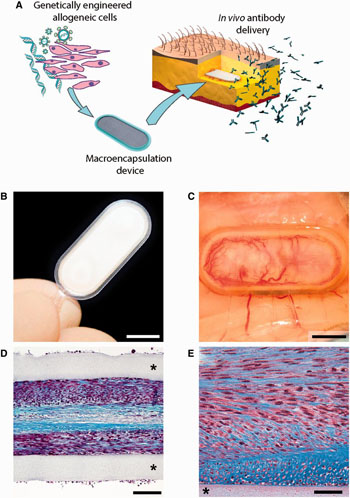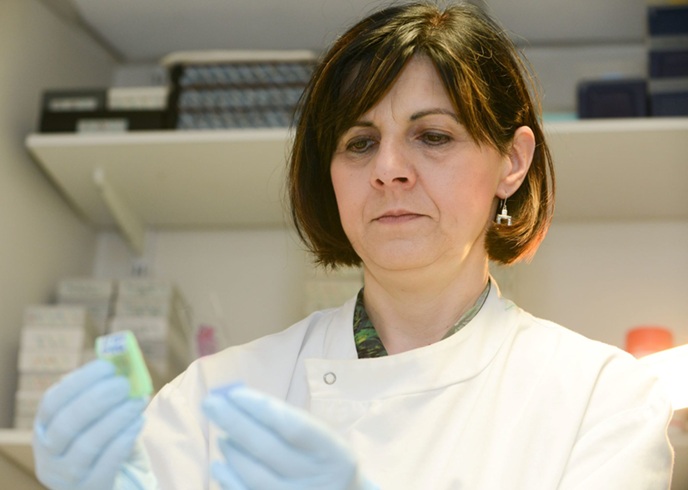Medical Implant Device Reduces Alzheimer’s Pathology and Provides Passive Immunization 
|
By LabMedica International staff writers Posted on 03 Apr 2016 |

Image: Schematic representation of implant for passive immunization by long-term therapeutic antibody delivery. Cells genetically engineered to produce a therapeutic antibody are confined in a macroencapsulation “flat sheet” device and implanted in the subcutaneous tissue for in vivo antibody secretion into the bloodstream. Antibodies reaching the brain target, clear, and prevent the harmful amyloid-beta protein plaques of Alzheimer’s disease (Photo courtesy of Lathuilière A et al, 2016, and Swiss Federal Institute of Technology in Lausanne).

Image: Infographic describing the newly developed implant device that may revolutionize therapy for patients with Alzheimer’s disease (Image courtesy of Lathuilière A et al., 2016, and Swiss Federal Institute of Technology in Lausanne).
In landmark proof-of-concept study with mice, a cutting-edge subcutaneous-implant capsule developed for treatment for Alzheimer’s disease, successfully directed the immune system against the disease.
One of the hypothesized causes of Alzheimer’s is over-accumulation of the protein amyloid-beta (Abeta) in different areas of the brain, resulting in deposition of aggregated protein plaques, which are toxic to neurons. One of the most promising treatments is to tag Abeta with antibodies that signal the patient’s own immune system to attack and clear them. To be most effective, this treatment has to be given as early, before the first signs of cognitive decline. Another drawback is that this treatment requires repeated vaccine injections, which can cause side effects.
The laboratory of Patrick Aebischer at the Swiss Federal Institute of Technology in Lausanne (EPFL – École Polytechnique Fédérale de Lausanne; Switzerland) have now innovatively solved the problem. The team developed a bioactive capsule containing cells genetically engineered to produce antibodies against Abeta. The capsule is implanted in tissue under the skin and the cells release a steady and safe flow of anti-Abeta antibodies into the bloodstream, from where they cross over into the brain and target the Abeta plaques.
The “macroencapsulation device” is made of two permeable membranes sealed together with a polypropylene frame. The membranes also allow the cells to interact with surrounding tissue to get the nutrients needed. The complete device is 27-mm long, 12-mm wide, 1.2-mm thick, and contains a hydrogel that facilitates cell growth. All the materials used are biocompatible, and a method was specifically used that is easily reproducible for large-scale manufacturing.
The cells in the capsule must be able to produce antibodies, but they must not trigger a rejection response in immune system (as with organ transplants). This is where the capsule membranes come into play: they shield the cells from being identified and attacked by the immune system. This protection also enables cells from a single donor to be used on multiple patients.
In the study, the device was successful in reducing pathology when tested on a mouse model for Alzheimer’s. Treatment resulted in a dramatic reduction of Abeta plaque load, and the constant flow of antibodies produced by the capsule over a course of 39 weeks prevented the formation of Abeta plaques in the brain. The treatment also reduced phosphorylation of the protein tau, another sign of Alzheimer’s.
The work demonstrated a proof-of-concept that encapsulated cell implants can be used successfully and safely to deliver antibodies to treat Alzheimer’s disease and other neurodegenerative disorders that feature defective proteins.
The study, by Lathuilière A et al., was published March 8, 2016, in the journal Brain.
Related Links:
Swiss Federal Institute of Technology in Lausanne
One of the hypothesized causes of Alzheimer’s is over-accumulation of the protein amyloid-beta (Abeta) in different areas of the brain, resulting in deposition of aggregated protein plaques, which are toxic to neurons. One of the most promising treatments is to tag Abeta with antibodies that signal the patient’s own immune system to attack and clear them. To be most effective, this treatment has to be given as early, before the first signs of cognitive decline. Another drawback is that this treatment requires repeated vaccine injections, which can cause side effects.
The laboratory of Patrick Aebischer at the Swiss Federal Institute of Technology in Lausanne (EPFL – École Polytechnique Fédérale de Lausanne; Switzerland) have now innovatively solved the problem. The team developed a bioactive capsule containing cells genetically engineered to produce antibodies against Abeta. The capsule is implanted in tissue under the skin and the cells release a steady and safe flow of anti-Abeta antibodies into the bloodstream, from where they cross over into the brain and target the Abeta plaques.
The “macroencapsulation device” is made of two permeable membranes sealed together with a polypropylene frame. The membranes also allow the cells to interact with surrounding tissue to get the nutrients needed. The complete device is 27-mm long, 12-mm wide, 1.2-mm thick, and contains a hydrogel that facilitates cell growth. All the materials used are biocompatible, and a method was specifically used that is easily reproducible for large-scale manufacturing.
The cells in the capsule must be able to produce antibodies, but they must not trigger a rejection response in immune system (as with organ transplants). This is where the capsule membranes come into play: they shield the cells from being identified and attacked by the immune system. This protection also enables cells from a single donor to be used on multiple patients.
In the study, the device was successful in reducing pathology when tested on a mouse model for Alzheimer’s. Treatment resulted in a dramatic reduction of Abeta plaque load, and the constant flow of antibodies produced by the capsule over a course of 39 weeks prevented the formation of Abeta plaques in the brain. The treatment also reduced phosphorylation of the protein tau, another sign of Alzheimer’s.
The work demonstrated a proof-of-concept that encapsulated cell implants can be used successfully and safely to deliver antibodies to treat Alzheimer’s disease and other neurodegenerative disorders that feature defective proteins.
The study, by Lathuilière A et al., was published March 8, 2016, in the journal Brain.
Related Links:
Swiss Federal Institute of Technology in Lausanne
Latest BioResearch News
- Genome Analysis Predicts Likelihood of Neurodisability in Oxygen-Deprived Newborns
- Gene Panel Predicts Disease Progession for Patients with B-cell Lymphoma
- New Method Simplifies Preparation of Tumor Genomic DNA Libraries
- New Tool Developed for Diagnosis of Chronic HBV Infection
- Panel of Genetic Loci Accurately Predicts Risk of Developing Gout
- Disrupted TGFB Signaling Linked to Increased Cancer-Related Bacteria
- Gene Fusion Protein Proposed as Prostate Cancer Biomarker
- NIV Test to Diagnose and Monitor Vascular Complications in Diabetes
- Semen Exosome MicroRNA Proves Biomarker for Prostate Cancer
- Genetic Loci Link Plasma Lipid Levels to CVD Risk
- Newly Identified Gene Network Aids in Early Diagnosis of Autism Spectrum Disorder
- Link Confirmed between Living in Poverty and Developing Diseases
- Genomic Study Identifies Kidney Disease Loci in Type I Diabetes Patients
- Liquid Biopsy More Effective for Analyzing Tumor Drug Resistance Mutations
- New Liquid Biopsy Assay Reveals Host-Pathogen Interactions
- Method Developed for Enriching Trophoblast Population in Samples
Channels
Clinical Chemistry
view channel
VOCs Show Promise for Early Multi-Cancer Detection
Early cancer detection is critical to improving survival rates, but most current screening methods focus on individual cancer types and often involve invasive procedures. This makes it difficult to identify... Read more
Portable Raman Spectroscopy Offers Cost-Effective Kidney Disease Diagnosis at POC
Kidney disease is typically diagnosed through blood or urine tests, often when patients present with symptoms such as blood in urine, shortness of breath, or weight loss. While these tests are common,... Read moreMolecular Diagnostics
view channel
Urine Test Detects Early Stage Pancreatic Cancer
Pancreatic cancer remains among the hardest cancers to detect early. In the UK, around 10,000 people are diagnosed each year, but only 5% survive beyond five years. Late diagnosis is a major factor—more... Read more
Genomic Test Could Reduce Lymph Node Biopsy Surgery in Melanoma Patients
Accurately determining whether melanoma has spread to the lymph nodes is crucial for guiding treatment decisions, yet the standard procedure—sentinel lymph node biopsy—remains invasive, costly, and unnecessary... Read moreHematology
view channel
Viscoelastic Testing Could Improve Treatment of Maternal Hemorrhage
Postpartum hemorrhage, severe bleeding after childbirth, remains one of the leading causes of maternal mortality worldwide, yet many of these deaths are preventable. Standard care can be hindered by delays... Read more
Pioneering Model Measures Radiation Exposure in Blood for Precise Cancer Treatments
Scientists have long focused on protecting organs near tumors during radiotherapy, but blood — a vital, circulating tissue — has largely been excluded from dose calculations. Each blood cell passing through... Read more
Platelets Could Improve Early and Minimally Invasive Detection of Cancer
Platelets are widely recognized for their role in blood clotting and scab formation, but they also play a crucial role in immune defense by detecting pathogens and recruiting immune cells.... Read more
Portable and Disposable Device Obtains Platelet-Rich Plasma Without Complex Equipment
Platelet-rich plasma (PRP) plays a crucial role in regenerative medicine due to its ability to accelerate healing and repair tissue. However, obtaining PRP traditionally requires expensive centrifugation... Read moreImmunology
view channel
Blood-Based Liquid Biopsy Model Analyzes Immunotherapy Effectiveness
Immunotherapy has revolutionized cancer care by harnessing the immune system to fight tumors, yet predicting who will benefit remains a major challenge. Many patients undergo costly and taxing treatment... Read more
Signature Genes Predict T-Cell Expansion in Cancer Immunotherapy
Modern cancer immunotherapies rely on the ability of CD8⁺ T cells to rapidly multiply within tumors, generating the immune force needed to eliminate cancer cells. However, the biological triggers behind... Read moreMicrobiology
view channel
Fast Noninvasive Bedside Test Uses Sugar Fingerprint to Detect Fungal Infections
Candida bloodstream infections are a growing global health threat, causing an estimated 6 million cases and 3.8 million deaths annually. Hospitals are particularly vulnerable, as weakened patients after... Read more
Rapid Sepsis Diagnostic Device to Enable Personalized Critical Care for ICU Patients
Sepsis is a life-threatening condition that occurs when the body’s response to infection spirals out of control, damaging organs and leading to critical illness. Patients often arrive at intensive care... Read morePathology
view channel
New Molecular Analysis Tool to Improve Disease Diagnosis
Accurately distinguishing between similar biomolecules such as proteins is vital for biomedical research and diagnostics, yet existing analytical tools often fail to detect subtle structural or compositional... Read more
Tears Offer Noninvasive Alternative for Diagnosing Neurodegenerative Diseases
Diagnosing and monitoring eye and neurodegenerative diseases often requires invasive procedures to access ocular fluids. Ocular fluids like aqueous humor and vitreous humor contain valuable molecular information... Read moreTechnology
view channel
Cell-Sorting Device Uses Electromagnetic Levitation to Precisely Direct Cell Movement
Sorting different cell types—such as cancerous versus healthy or live versus dead cells—is a critical task in biology and medicine. However, conventional methods often require labeling, chemical exposure,... Read more
Embedded GPU Platform Enables Rapid Blood Profiling for POC Diagnostics
Blood tests remain a cornerstone of medical diagnostics, but traditional imaging and analysis methods can be slow, costly, and reliant on dyes or contrast agents. Now, scientists have developed a real-time,... Read moreIndustry
view channel
Puritan Medical Products Showcasing Innovation at AMP2025 in Boston
Puritan Medical Products (Guilford, ME, USA), the world’s most trusted manufacturer of swabs and specimen collection devices, is set to exhibit at AMP2025 in Boston, Massachusetts, from November 11–15.... Read more
Advanced Instruments Merged Under Nova Biomedical Name
Advanced Instruments (Norwood, MA, USA) and Nova Biomedical (Waltham, MA, USA) are now officially doing business under a single, unified brand. This transformation is expected to deliver greater value... Read more






















